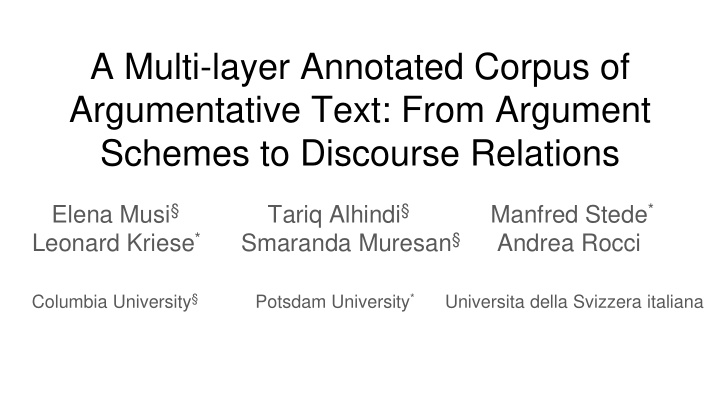



A Multi-layer Annotated Corpus of Argumentative Text: From Argument Schemes to Discourse Relations Elena Musi § Tariq Alhindi § Manfred Stede * Leonard Kriese * Smaranda Muresan § Andrea Rocci Columbia University § Potsdam University * Universita della Svizzera italiana
Motivation ● Advance our understanding of the correlations between discourse structure and argumentation structure (both argument relations and inference rules) ● Advance Argumentation Mining: datasets labeled with inferential relations ---argument schemes --- are scarce
Many people see proven relief of their symptoms and complaints by complementary medicine. However there is no substantiated data that this healing isn't simply due to the placebo effect. Besides many practices in this field are not regulated professions which means that quacks and phonies can practice these occupations unknown to the patients. That's why the statutory health insurance companies should not cover such treatments. It would be conceivable to invest more into the training and control of this occupation sector on the part of the state.
Many people see proven relief of their symptoms and complaints by complementary medicine. However there is no substantiated data that this healing isn't simply due to the placebo effect. Besides many practices in this field are not regulated professions which means that quacks and phonies can practice these occupations unknown to the patients. That's why the statutory health insurance companies should not cover such treatments. It would be conceivable to invest more into the training and control of this occupation sector on the part of the state.
Discourse Structure Rhetorical Strucuture Theory (RST)
Argument Structure UNDERCUT REBUT SUPPORT Freeman, J. B. (2011). Argument Structure: Representation and Theory. Stede, M., Afantenos, S. D., Peldszus, A., Asher, N., & Perret, J. (2016). Parallel Discourse Annotations on a Corpus of Short Texts. In LREC .
Argument Schemes
Stede, M., Afantenos, S. D., Peldszus, A., Asher, N., & Perret, J. (2016). Parallel Discourse Annotations on a Corpus of Short Texts. In LREC . Stede et al. 2016 Annotation Study Correlation Study
Aim of the study ● Propose guidelines for the annotation of argument schemes for both SUPPORT and REBUT relations ○ using the Argumentum Model of Topics ● Report an annotation project of inferential rules (argument schemes) on microtext corpus that already has ○ argument structure ○ discourse structure based on both RST and Segmented Discourse Representation Theory (SDRT) ● A multi-layer resource for correlating different levels of discourse and argumentative analysis ● Present a new annotation tool for argument schemes
Outline ● Corpus ● Annotation guidelines ● Annotation results ● Argument schemes and rhetorical discourse relations ○ Mapping the two theories ○ Correlation analysis ● Discussion ● Conclusion
Corpus ● Argumentative microtext corpus: 112 short texts created through a text generation experiment (Peldszus and Stede, 2016) ● Supported levels of annotation: Argument structure Discourse structure (both according to RST and SDRT)
Annotation Theory and Task Argumentum Model of Topics 2 tasks: • given a SUPPORT or REBUT relation, identify the argument scheme among the 8 middle level schemes • identify the associated inference rule Musi, E., Ghosh, D., and Muresan, S. (2016). Towards feasible guidelines for the annotation of argument schemes. In Proceedings of the third workshop on argument mining (ArgMining2016), pages 82 – 93.
Annotation Tool
Inter-Annotator Agreement k (1 st Set) k (2 nd Set) Annotators Annotators 1, 2 0.404 4, 5 0.213 2, 3 0.231 5, 6 0.260 1, 3 0.231 4, 6 0.409
Annotation Results
Argument Schemes and Rhetorical Relations ● Mapping the two theories ○ Representing argument structure along with the annotated argument schemes in one common format with RST discourse structure ○ Using a dependency structure (Stede et al., 2016) ● Correlation Analysis ○ Overlap between RST relations and argument schemes for SUPPORT and REBUT relations
Argument Structure Stede, M., Afantenos, S. D., Peldszus, A., Asher, N., & Perret, J. (2016). Parallel Discourse Annotations on a Corpus of Short Texts. In LREC .
Discourse Structure Stede, M., Afantenos, S. D., Peldszus, A., Asher, N., & Perret, J. (2016). Parallel Discourse Annotations on a Corpus of Short Texts. In LREC .
Dependency Structure Argument Schemes RST relations
Overlap between RST and argument schemes SUPPORT REBUT
Overlap between RST and argument schemes SUPPORT REBUT
Overlap between RST and argument schemes SUPPORT REBUT
Overlap between RST and argument schemes SUPPORT REBUT
Discussion ● Presentational RST relations: ANTITHESIS and CONCESSION REBUT relations ( e.g.“A lthough IBM s num- bers haven’t been staggering recently. You should buy IBM shares if you want to invest”) REASON SUPPORT relations e.g. REASON PRACTICAL EVALUATION argument schemes (e.g. “ Actually only those people should pay a TV and radio licence fee who really watch ARD, ZDF, Arte etc. It is in fact good to support sophisticated programming through fees”) ● Subject-matter RST relations: CAUSE Argument schemes of the CAUSAL type ( “Fees result in longer durations of studies” supported by the premise “That’s costly!” )
Conclusion ● We provided a multilayer annotated corpus that allowed us to study the correlation between different levels of discourse and argumentative relations ● Presentational RST relations correlates with either SUPPORT or REBUT relations but do not select a specific scheme ● It seems that Subject-matter RST relations select one top-level type of scheme (intrinsic or extrinsic). ● This was done on small scale, so we need to do it on a larger dataset next
Thank You
Recommend
More recommend